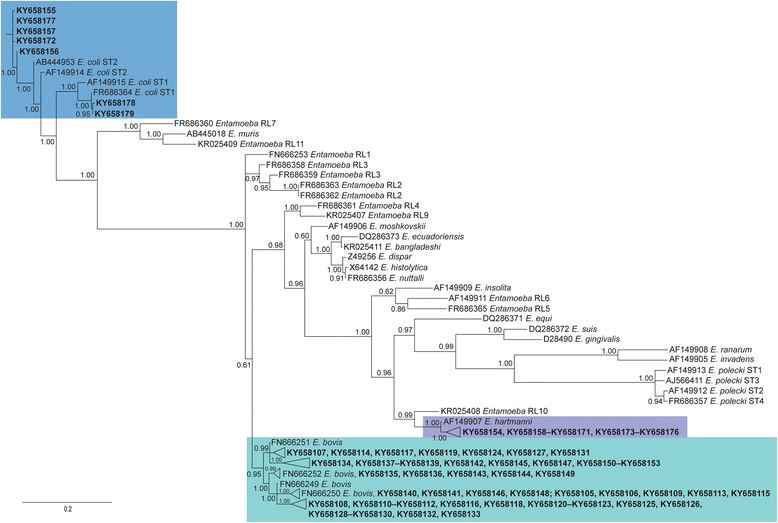Molecular characterisation of protist parasites in human-habituated mountain gorillas (Gorilla beringei beringei), humans and livestock, from Bwindi impenetrable National Park, Uganda
- PMID: 28720110
- PMCID: PMC5516388
- DOI: 10.1186/s13071-017-2283-5
Molecular characterisation of protist parasites in human-habituated mountain gorillas (Gorilla beringei beringei), humans and livestock, from Bwindi impenetrable National Park, Uganda
Abstract
Background: Over 60 % of human emerging infectious diseases are zoonotic, and there is growing evidence of the zooanthroponotic transmission of diseases from humans to livestock and wildlife species, with major implications for public health, economics, and conservation. Zooanthroponoses are of relevance to critically endangered species; amongst these is the mountain gorilla (Gorilla beringei beringei) of Uganda. Here, we assess the occurrence of Cryptosporidium, Cyclospora, Giardia, and Entamoeba infecting mountain gorillas in the Bwindi Impenetrable National Park (BINP), Uganda, using molecular methods. We also assess the occurrence of these parasites in humans and livestock species living in overlapping/adjacent geographical regions.
Results: Diagnostic PCR detected Cryptosporidium parvum in one sample from a mountain gorilla (IIdA23G2) and one from a goat (based on SSU). Cryptosporidium was not detected in humans or cattle. Cyclospora was not detected in any of the samples analysed. Giardia was identified in three human and two cattle samples, which were linked to assemblage A, B and E of G. duodenalis. Sequences defined as belonging to the genus Entamoeba were identified in all host groups. Of the 86 sequence types characterised, one, seven and two have been recorded previously to represent genotypes of Cryptosporidium, Giardia, and Entamoeba, respectively, from humans, other mammals, and water sources globally.
Conclusions: This study provides a snapshot of the occurrence and genetic make-up of selected protists in mammals in and around BINP. The genetic analyses indicated that 54.6% of the 203 samples analysed contained parasites that matched species, genotypes, or genetic assemblages found globally. Seventy-six new sequence records were identified here for the first time. As nothing is known about the zoonotic/zooanthroponotic potential of the corresponding parasites, future work should focus on wider epidemiological investigations together with continued surveillance of all parasites in humans, other mammals, the environment, and water in this highly impoverished area.
Keywords: Cryptosporidium; Entamoeba; Giardia; Infectious disease; Zooanthroponosis; Zoonosis.
Conflict of interest statement
Ethics approval and consent to participate
The Uganda Wildlife Authority, the Uganda National Council for Science and Technology, the Institutional Review Board at the Mbarara University of Science and Technology and the Ethical Review Committees of the Zoological Society of London and the Royal Veterinary College approved this study. All human participants gave their written informed consent to be involved in this study. For individuals < 18 years of age, written consent was provided by a parent or guardian. Once collected by health technicians from Bwindi Community Hospital and Kayonza Health Center III, Uganda, all human samples were anonymized. Gorilla faecal samples were collected from night nests by MU and GK-Z after gorillas had left the area: there was no direct contact with the gorillas at any time. Prior, written informed consent was obtained from farmers before faecal samples were collected from livestock animals on private farms. All faecal samples were transported to the Royal Veterinary College, London, United Kingdom in strict accordance with the Importation of Animal Pathogens Order Permit (No: AHZ/2034/2001/2), issued by the UK Department for Environment, Food, and Rural Affairs.
Consent for publication
All human participants gave their written informed consent for data from this work to be published. For individuals < 18 years of age, written consent was provided by a parent or guardian. Written consent was obtained from farmers for data derived from livestock to be published.
Competing interests
The authors declare that they have no competing interests.
Publisher’s Note
Springer Nature remains neutral with regard to jurisdictional claims in published maps and institutional affiliations.
Figures
Similar articles
-
Giardia in mountain gorillas (Gorilla beringei beringei), forest buffalo (Syncerus caffer), and domestic cattle in Volcanoes National Park, Rwanda.J Wildl Dis. 2014 Jan;50(1):21-30. doi: 10.7589/2012-09-229. Epub 2013 Oct 25. J Wildl Dis. 2014. PMID: 24171566
-
Cryptosporidium parvum genotype 2 infections in free-ranging mountain gorillas (Gorilla gorilla beringei) of the Bwindi Impenetrable National Park, Uganda.Parasitol Res. 2001 May;87(5):368-70. doi: 10.1007/s004360000337. Parasitol Res. 2001. PMID: 11403378
-
Prevention of Cryptosporidium and GIARDIA at the Human/Gorilla/Livestock Interface.Front Public Health. 2018 Dec 14;6:364. doi: 10.3389/fpubh.2018.00364. eCollection 2018. Front Public Health. 2018. PMID: 30619805 Free PMC article.
-
Zoonotic parasites of dromedary camels: so important, so ignored.Parasit Vectors. 2019 Dec 27;12(1):610. doi: 10.1186/s13071-019-3863-3. Parasit Vectors. 2019. PMID: 31881926 Free PMC article. Review.
-
Review of zoonotic parasites in medical and veterinary fields in the Republic of Korea.Korean J Parasitol. 2009 Oct;47 Suppl(Suppl):S133-41. doi: 10.3347/kjp.2009.47.S.S133. Korean J Parasitol. 2009. PMID: 19885329 Free PMC article. Review.
Cited by
-
Parasitic Infections in African Humans and Non-Human Primates.Pathogens. 2020 Jul 11;9(7):561. doi: 10.3390/pathogens9070561. Pathogens. 2020. PMID: 32664573 Free PMC article.
-
First report of Giardia duodenalis in dairy cattle and beef cattle in Shanxi, China.Mol Biol Rep. 2024 Mar 8;51(1):403. doi: 10.1007/s11033-024-09342-7. Mol Biol Rep. 2024. PMID: 38457002
-
Sparse Evidence for Giardia intestinalis, Cryptosporidium spp. and Microsporidia Infections in Humans, Domesticated Animals and Wild Nonhuman Primates Sharing a Farm-Forest Mosaic Landscape in Western Uganda.Pathogens. 2021 Jul 23;10(8):933. doi: 10.3390/pathogens10080933. Pathogens. 2021. PMID: 34451397 Free PMC article.
-
Cryptosporidium parvum and Cryptosporidium hominis subtypes in crab-eating macaques.Parasit Vectors. 2019 Jul 15;12(1):350. doi: 10.1186/s13071-019-3604-7. Parasit Vectors. 2019. PMID: 31307508 Free PMC article.
-
Diversity, geographical distribution, and prevalence of Entamoeba spp. in Brazil: a systematic review and meta-analysis.Parasite. 2021;28:17. doi: 10.1051/parasite/2021028. Epub 2021 Mar 30. Parasite. 2021. PMID: 33812449 Free PMC article.
References
MeSH terms
Substances
LinkOut - more resources
Full Text Sources
Other Literature Sources
Medical
Molecular Biology Databases
Research Materials


